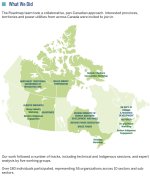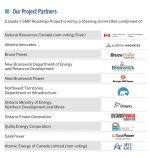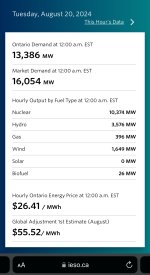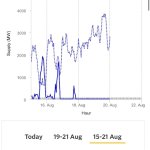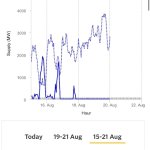Alberta: “Preach, brother!”
If only more people understood base load vs. green unicorn sourced electricity (that all too often takes the proverbial trip to the washroom when the bill arrives at the table)…
Ontario is not a beholden buyer. It has a peak generation capacity of approx 40GW, adjusted to ~35GW base load when you subtract 4.8GW of wind and 480MW of solar. It usually peaks at 22-23GW use, with more than 10+ GW in reserve (usually the more expensive and greater CO2-emitting NG plants in reserve).
As SKT noted earlier…base load generation capability isn’t something to be under appreciated. Guess what forms the unquestionable base load capacity in Ontario? It doesn’t get any clearer than that…all 10GWs worth of it…rain or shine, wind or no wind…sun or no sun…
View attachment 87430
You can see a detailed breakdown of OPG’s capacity and realtime output by source type and location/facility here:
OPG’s actual output is adjusted to provide for Ontario’s internal demand and that of its export clients (other Canadian provinces and US States).
For example, just after midnight on 20 August, Ontario was consuming 13.4GW of power and exporting 2.6GW to export users.
View attachment 87427
Ontario will sometimes import electricity, not because of necessity, but based on cost. If there’s cheaper hydro available from Quebec or Manitoba for instance, it imports that, while it exports to the US at a higher rate (see this chart from
IESO Power Supply for the last few days of OHO’s import/exports. Note for example that late on 15 Aug, while Ontario was net importing power, ie. importing 2.0GW of electricity (the solid blue line, likely QC hydro) it was still exporting 0.8-1.0GW (blue dashed line, likely to Michigan or NY, traditional peak importers of ON power).
View attachment 87429
You can see more detail of Ontario electricity export clients
here, but big players are Michigan at 9000 GWh and New York at 5000 GWh annually.
Interestingly, while Ontario did import 7000 GWh from Quebec (2022), it also exported 3000 GWh back to Quebec…ON and QC production costs interestingly are partial offset in time so they horse trade to each other at their cheaper rates while exporting to the US at their respective higher selling rates.
As noted earlier, Ontario isn’t a beholden buyer. It had close to 40GW of generation capability and average peaks in the ~25GW range. It just chooses not to flash up its 10GW of NG generation unless it really would need to (like Alberta needed to in February when the wind stopped blowing and Sun was on the other side of the planet…)
Separate from the economics and practicality of electricity discussed above, what Newfoundlanders like to believe about Joey Smallwood often conveniently forgets that he was the dude that signed the deal with Quebec to give all the Great Whale power away at basement bargain rates, thus beholding Newfoundland to Quebec.


